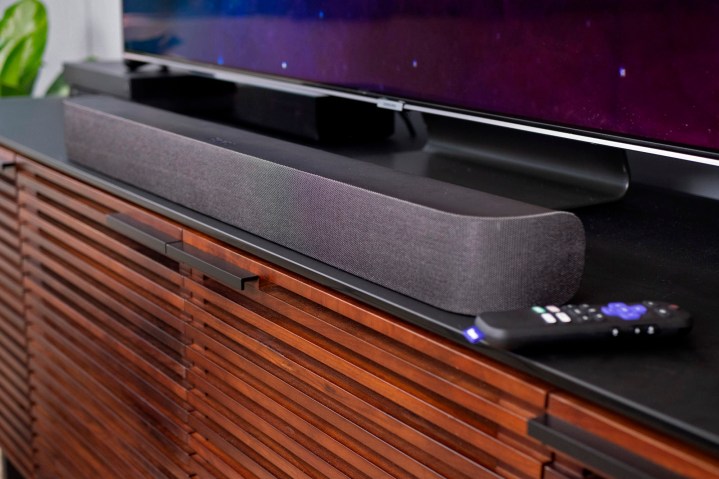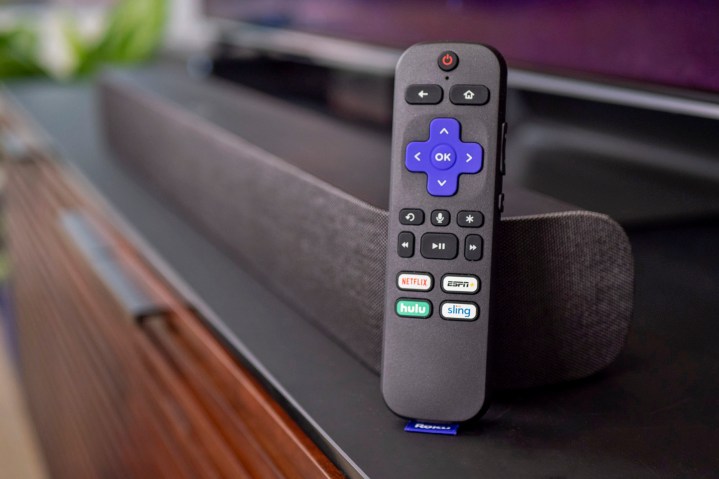Simple, immersive, affordable surround sound. That’s the promise of Roku’s new operating system update, which allows you to link up the company’s soundbar, sub, and Roku Wireless Speakers for a slick and concise surround setup that costs just $500.
On many fronts, Roku’s makeshift system delivers on its promise, booming and sweeping its way to some pretty sweet cinematic immersion. But, after spending some quality time with the newly minted setup, I can tell you it won’t be for everyone, especially those looking for a system as musical as it is cinematic.
Here are the highs and lows of Roku’s new Voltron-style surround setup.
Setup (no-fuss presumably)

Roku’s new system is designed to be so easy to use that even your aging Aunt Freda can set it up and enjoy those mahjong tournaments on ESPN 7 in immersive surround. Roku shoots for a broad audience, so the system needs to be accessible for all. For the most part, that’s the case when it comes to setup, but there are some caveats to mention.
The Roku Smart Soundbar is basically a
That’s assuming the new update that makes this possible goes off without a hitch, of course. Updates can be tricky, and you may need to hit the reset button on the speakers or sub, though the simple on-screen directions should make this clear. However, since the Roku Wireless Speakers were originally designed to pair to a
You’ll also need to find a place to set up the speakers behind (and to the left and right of) the listening position. This will likely require you to pick up speaker stands or find a console for them, etc. So, while the setup is simple, it isn’t necessarily a breeze for surround newbies.
Features

That’s not to say this system isn’t intuitive as all get-out — it’s Roku, after all — and operation is a snap once you’re up and running. Apart from the luxury of a built-in video streamer, easy access to on-screen sound settings, a signature perk of
A tap of the star key on the soundbar’s remote calls up a small but effective suite of settings, including leveling and night mode (for keeping the system from blasting during commercials or when the kids are sleeping), two settings to pump up dialogue (low and high), and a range of bass controls for the subwoofer. The settings are limited, but work well for those for whom a graphic EQ is as mysterious as quantum physics.
Like most modern soundbars, the system also works seamlessly with your TV remote for power and volume when connected via HDMI ARC (cable included).
There’s also a cool feature called Expanded Stereo mode, which uses digital signal processing (DSP) to pump ambient sound into the surround satellites for stereo content. The Movies and TV mode, which is on by default, actually works impressively well, seeming to magically pull only the background effects into the back speakers for a more immersive experience. I was less impressed with the Music version when streaming Bluetooth, but it does give you a bigger soundstage.
Smart assistant support includes Amazon Alexa and Google Assistant for some basic functionality like streaming from select services, volume control, and turning the system on and off, while the microphone in the remote allows for searching streaming content via Roku’s operating system as well.
Interface
The opposite side of the coin that is Roku’s dead-simple interface is that, well, there’s not a lot you can do to tune the system manually. For control freaks like yours truly, the lack of incremental levels for the subwoofer and (especially) zero control over the satellites is maddening. While there are settings that raise or lower bass output, the only way to control the surround volume appears to be where you place them in conjunction with your listening position.
Also somewhat frustrating is Bluetooth streaming, which demands you go through the settings via your TV for initial pairing. I’d rather just have an input key. That said, once you’ve paired to it, the system is designed to allow you to stream to the bar with the TV off (though for my TCL 6-series Roku TV, it seemed to turn on the TV when I turned on the bar).
Speaking of inputs, the options are limited. Unlike competitors such as Vizio’s $500 SB36512-g6 surround soundbar (which also tacks on Dolby Atmos, by the way), there’s no way to stream over Wi-Fi, or even a 3.5mm input.
Performance

When it comes to performance, the highlights of this four-piece system are easily the subwoofer and satellite components, which deliver power and immersion, respectively, that rises above what you’ll get from the vast majority of competitors at this price point.
After connecting the sub, Roku’s booming test demo freaked out my normally quiet dog from a dead slumber, causing him to bark as viciously as a 15-pounder can at what he deemed a full-on invasion. The impressive little tub holds court in everything from major action scenes to acoustic tracks, offering clean and powerful bass that punches well above its weight when measured by both size and price point.

Meanwhile, the Roku Wireless speakers offer power and clarity that’s far above what you’ll see in most surround bars in this price class (or even well above it). Designed as stand-alone speakers for
The result is excellent immersion that really pulls you into the moment in films like Avengers: Infinity War and The Dark Knight. But the setup also leaves something to be desired when it comes to the weakest link in this chain, the soundbar itself.
While the bar is the piece that ties it all together, it’s also the wild card of the system. Loaded with DSP, at times it can sound quite good, reveling in the meat of the sound for clean and detailed midrange effects and dialogue. At other times, you’re reminded of its stubby size, which limits its soundstage significantly, while it’s smaller tweeters seem to be stretching to produce more velocity, resulting in a shouty sound signature.
That goes for music playback, too, which often comes off flat and boxy. My first impression when I called up a Spotify playlist was that of disappointment as the soundstage seemed to collapse on itself significantly. The subwoofer helps take some of the load, adding punch to songs that hit hard and chocolaty bass to acoustic fare, but I often wished for more warmth and presence in the middle of the sound and more definition up top.
This wasn’t always the case — I certainly found myself enjoying some tunes, usually those with excellent mixing, but in general, Bluetooth streaming is lackluster. You can lean on the Roku Wireless Speakers a bit by engaging the Expanded Stereo Music mode, but it can’t really make up for the lack of musicality upfront. And perhaps ironically, I found myself wishing I was just listening to the twin speakers on their lonesome instead.
Conclusion
At $500, Roku’s mostly wireless surround setup has a lot going for it. It’s slick and simple to use, offers a great streamer built-in (assuming you don’t already have one), and provides compelling surround sound immersion for your favorite cinematic scenes. It’s not the best for music streaming, though, and while it’s easy to use, I find its limitations in both connection options and settings frustrating.
If you love the simple and intuitive nature of Roku — and especially if you’ve already invested in one of these components — the full system might be a good option. Otherwise, you can get more well-rounded surround solutions from Vizio and other brands, often for less.
Updated 2/20/2020: This piece has been updated to clarify that basic smart assistant functionality is supported for Google Assistant and Amazon Alexa.
Editors' Recommendations
- Ultimate surround sound guide: DTS, Dolby Atmos, and more explained
- YouTube TV adds 5.1 surround sound on Roku, Android TV, Google TV
- Soundbars vs. speakers
- Roku OS 10 adds Apple AirPlay, virtual surround sound, and better Wi-Fi
- Polk’s $249 expandable React Soundbar packs virtual 5.1 surround sound and Alexa


